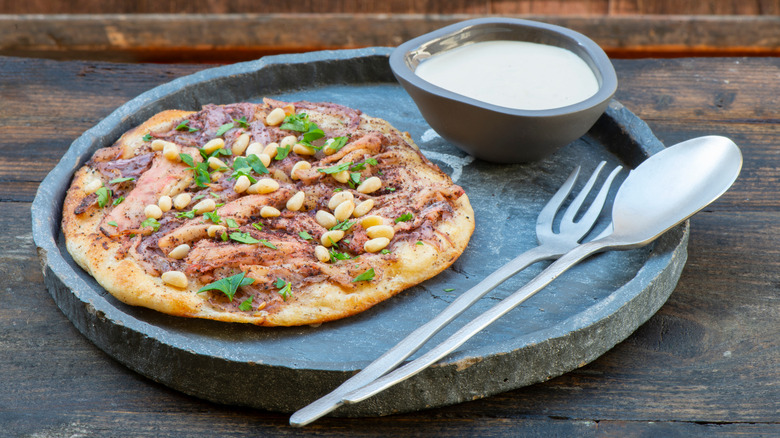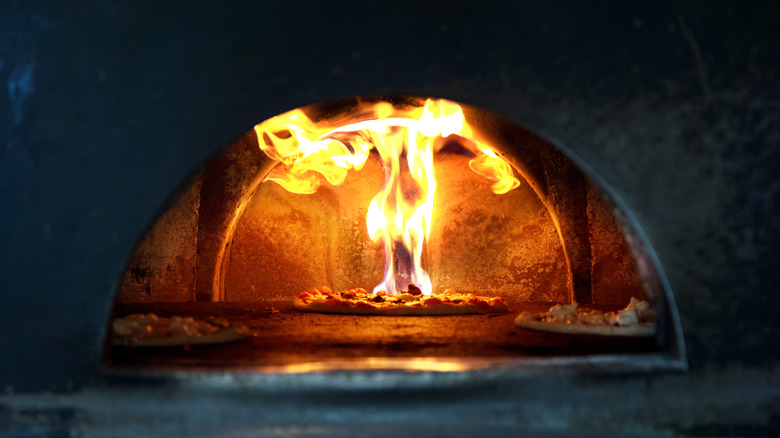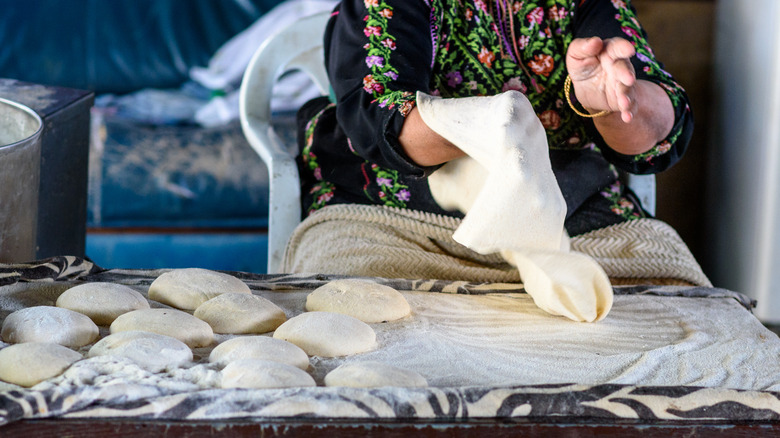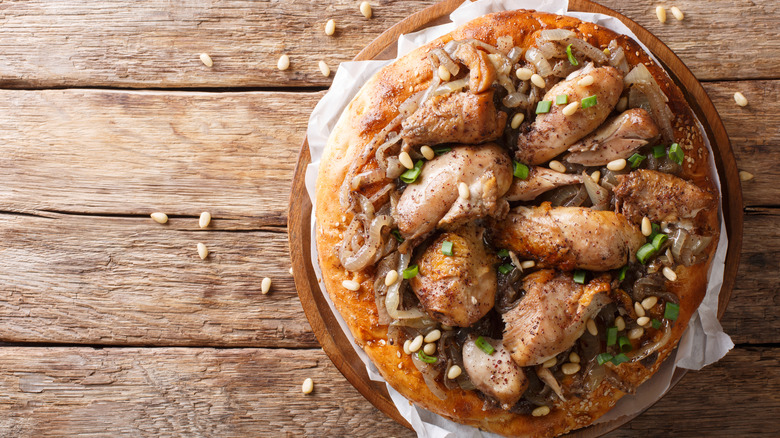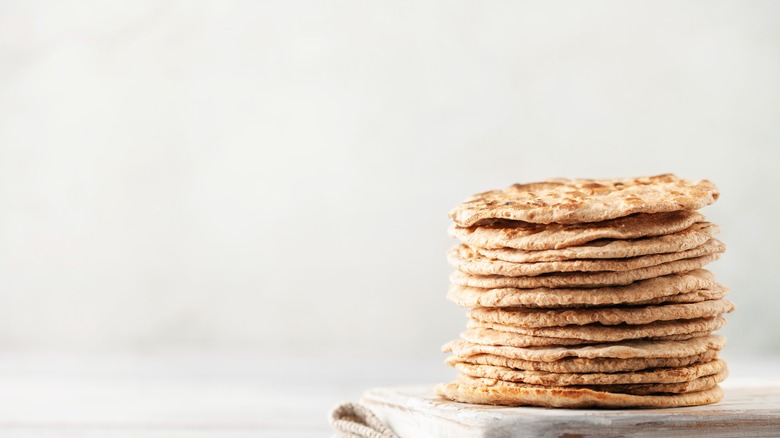What Is Taboon Bread And How Is It Served?
Look at the world's culinary traditions and you'll see many types of flatbreads in a variety of cultures. Pita bread originated in Ancient Mesopotamia before spreading to the Middle East and the Mediterranean, tortillas came from corn growers in Mexico, and Indians perfected naan bread in South Asia, notes Oola.
Cultures across Europe, the Middle East, and Asia have communal breadmaking traditions that date back thousands of years, according to CGTN. In Armenia, families and neighbors come together to make large pieces of lavash in a firepit in the ground. France's baguettes earned a spot on the U.N.'s Intangible Cultural Heritage list (via NPR).
Taboon bread comes to us from Palestine and other Middle Eastern traditions, notes Chef Tariq. Traditionally, taboon bread forms the bottom layer of musakhan, a delicacy from the Middle East featuring flatbread topped with roasted chicken rubbed with a layer of olive oil and seasoned with chopped onions, a teaspoon of sumac, and a pinch of salt. Modern recipes for taboon have a history dating back to the first known times humans began to bake bread.
History of taboon bread
Evidence of breadmaking in the Middle East dates back over 14,000 years, right about the time humans began to cultivate wheat, according to Serious Eats. Each village and region had its own version of a flatbread, and they each called it different names. For the region of Palestine, locals called it taboon bread. The name taboon bread comes from the traditional type of oven it was baked in.
Chef Tariq describes this Palestinian flatbread as a heartier version of pita bread. Made by hand throughout the course of a day, taboon offers a lesson not just in making tasty bread with simple ingredients, it's passing on a way of life for many families. Also known as lafah bread, this delicacy is soft and chewy, according to Lin's Food, thanks to the way it's cooked. For traditional taboon, breadsmiths spread each piece over stones that sit above a bed of hot coals in a clay oven over high heat, says Serious Eats. And that's after burning wood overnight to form the bed of coals. The stones, according to Chef Tariq, are what make the signature dimples you'll see on the outside layer of taboon bread. They also help make the bread very soft on the inside.
Versatility of taboon bread
This Palestinian flatbread offers versatility perfect for wraps, as a base for entrees, and for stuffing with your favorite ingredients, according to Lin's Food. Just like your own family's traditions, there are many ways to incorporate taboon into your daily meals.
Another authentic recipe comes from the grandmother of Reem Kassis, writing for Serious Eats. The author remembers her grandmother laying out vegetables over the same stones used to cook the taboon bread. Her family would eat this version of flatbread topped with a mixture of mashed eggplant, green chilies, and tomatoes.
Lin's Food notes you can wrap shawarma with taboon bread, placing heaping spoonfuls of falafel and hummus inside for a versatile dish. Taboon bread is great as a sandwich wrap for whatever ingredients you want, like chicken and bacon. How about pizza? Taboon Bakery has a delicious take on pizza combining a taboon bread recipe and Italian favorites. Imagine the personal-sized pizzas you can make at home with this type of flatbread! Don't worry, if you don't have a clay oven at home, there are more modern methods to make this flatbread.
Making taboon bread today
Clay ovens are a bit hard to come by in modern kitchens. Lin's Food suggests using a pizza stone in place of rocks, just make sure to preheat the stone before baking the bread. The downside is that you can only make a few pieces at a time with a pizza stone, depending on the size of your oven. Lin uses her knuckles to create the dimples. You can also try putting pebbles in a shallow baking dish to get those signature indentations in the bread.
Serious Eats has a simple recipe for making taboon bread, using bread and whole wheat flours, salt, sugar, olive oil, instant yeast, and warm water. The trick is to cover the dough with a paper towel and let it sit on your countertop for around two hours for it to expand. Then split it up into equal portions before rolling them flat until they're between six and eight inches across. Bake on your preheated pizza stone or in a cast iron skillet covered with a bottom layer of pebbles at 500 degrees Fahrenheit for about five minutes and you will have homemade taboon in no time.
Taboon compared to other Middle Eastern flatbreads
Taboon has several flatbread friends in the Middle East, notes 196 Flavors. Khubz tannur comes to us from Iraq. It's a catch-all flatbread that brings all of the flavors of the dishes together, much like dipping a bread into sauce or having a pizza. Khubz tannur is similar to taboon in that you pile toppings on it, much like pizza, but it's not as fluffy as taboon and has a consistency closer to pita bread. Once this type of flatbread hits the table, notes the Los Angeles Times, it turns crispy and loses its softness.
Pita is a popular flatbread that originated in the Middle East, although it's most notably used in Greek dishes. You'll be hard-pressed to find a Greek-American gyro sandwich not made with pita bread, says Dimitra's Dishes. Pita plumps up when you bake it and forms a nice pocket to stuff items with, which is not inherent in taboon.
An Iraqi flatbread called lafah is similar to taboon and khubz tannur, except it's a bit wider and is traditionally made with olive oil. The Spruce Eats says lafah is even softer than taboon, if you can believe bread can get any softer. Whatever your flatbread of choice, there are plenty of traditions to pass on and tons of delectable flavors to enjoy.
